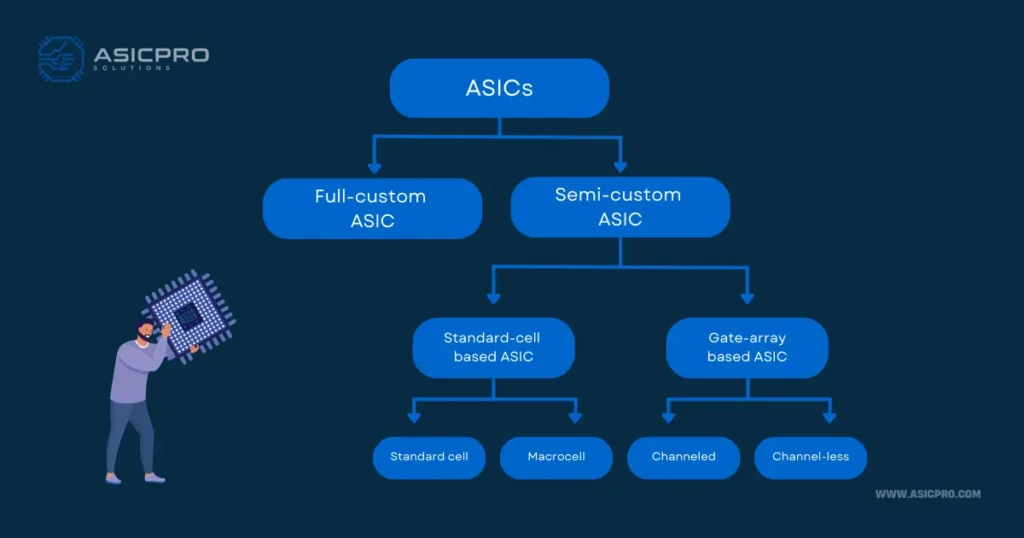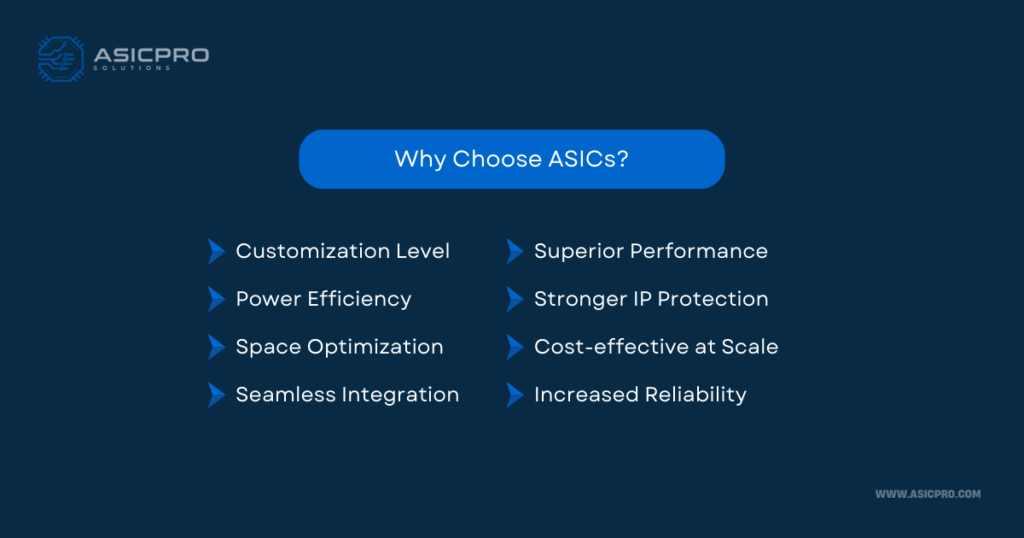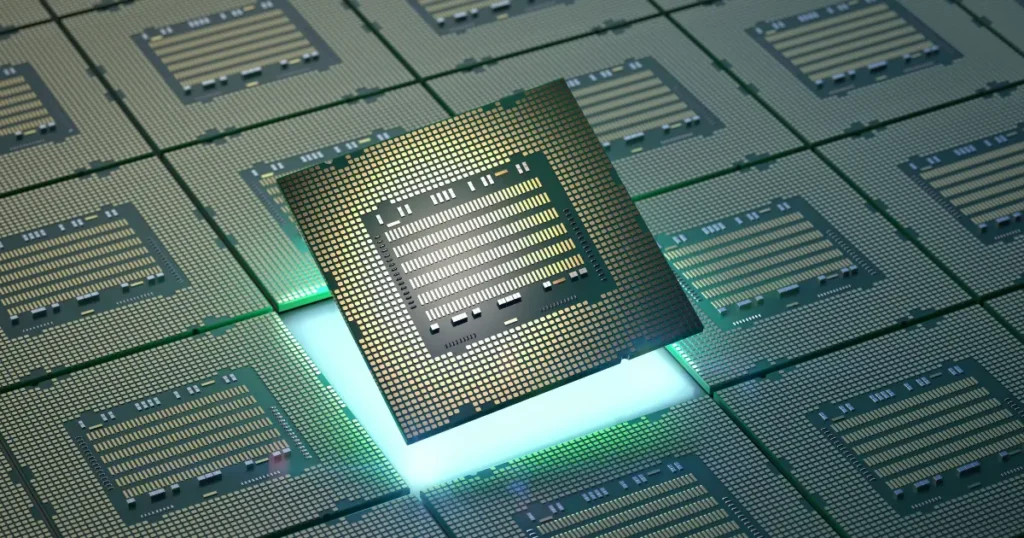What is an ASIC?
An Application-Specific Integrated Circuit (ASIC) is a semiconductor chip designed for a specific task or application. Unlike general-purpose processors, which can handle a wide range of functions, ASICs are custom-built to optimize performance, efficiency and power consumption for a targeted purpose. This level of specialization makes them essential for applications where high performance, energy efficiency and miniaturization are most critical.
ASICs power many of today’s cutting-edge technologies, playing a key role in industries such as consumer electronics, automotive, healthcare, telecommunications, AI and cloud computing. From accelerating AI workloads to maximizing battery performance in mobile devices, ASICs are shaping the future of technology.
What are the main types of ASICs?

ASICs are typically split into two main categories based on their level of customization:
Full-Custom ASICs
Full-custom ASICs are designed from the transistor level up, allowing for maximum performance, power efficiency and area optimization. This level of precision makes them ideal for high-performance computing, data networking, telecommunications and advanced AI applications. While full-custom ASICs require longer development cycles and higher costs, they are often the top choice when maximum performance is the highest priority.
Semi-Custom ASICs
Semi-custom ASICs use standard cells to balance customization and cost. By leveraging pre-designed building blocks such as logic gates and memory elements, designers can achieve optimized functionality without the complexity of a full-custom design. This approach typically reduces development cycles, making semi-custom ASICs ideal for applications where time-to-market and affordability take priority over full customization.
Why Choose ASICs?

ASICs offer several distinct advantages over general-purpose processors and programmable alternatives like FPGAs, making them the preferred solution for high-performance, power-sensitive applications. According to Arm, custom silicon helps mitigate supply chain risks, reduce device size, improve power efficiency and enhance competitive advantage.
Key advantages:
Whether full-custom or semi-custom, application-specific integrated circuits deliver tailored performance and efficiency that help products stand out in competitive markets.
1. Performance Optimization
Designed for specific tasks, ASICs deliver faster processing and higher computational efficiency than off-the-shelf solutions. Full-custom ASICs provide the greatest level of performance, while semi-custom designs still achieve significant speed improvements with shorter development cycles.
2. Power Efficiency
ASICs consume less power by eliminating unnecessary logic and optimizing for specific workloads. This makes them ideal for energy-sensitive and battery-powered applications. Full-custom designs offer maximum power savings, while semi-custom ASICs strike a strong balance between efficiency and design effort.
3. Compact & Space-Efficient
By integrating multiple functions into a single chip, ASICs reduce overall system size and complexity. Full-custom designs achieve the most compact layouts, but even semi-custom ASICs contribute to smaller, more streamlined hardware.
4. Cost-Effective at Scale
While ASIC development can involve higher upfront costs, they become highly cost-efficient in high-volume production. Full-custom ASICs maximize cost savings per unit at high volumes, whereas semi-custom designs offer a more affordable entry point with faster time to market.
5. Enhanced Security & Reliability
Custom ASICs reduce exposure to common vulnerabilities associated with off-the-shelf components. They also give developers greater control over the hardware supply chain. Both full and semi-custom designs support tighter security, with full-custom offering the highest level of customization.
Where Are ASICs Making an Impact?
From everyday electronics to cutting-edge innovations, ASICs power the technologies that shape our world. Their ability to deliver tailored performance makes them a preferred choice across a wide range of industries, including:
- Consumer Electronics: Smartphones, smartwatches and tablets all rely on ASICs for efficient processing, power management and advanced features like facial recognition and voice assistants.
- Automotive: The future of mobility is being driven by software-defined vehicles – cars that rely on tight integration between hardware and software to deliver advanced features and seamless updates. From enabling advanced driver-assistance systems (ADAS) and managing batteries in EVs to supporting infotainment and in-vehicle communication, ASICs are playing a key role in this transformation.
- Artificial Intelligence & Machine Learning: Custom chips like Google Trillium TPUs, designed specifically for AI workloads, dramatically accelerate training and inference processes, delivering the speed and energy efficiency that general-purpose processors can’t match.
ASICs are also widely used in telecommunications, healthcare, medical devices, aerospace, and beyond. As ASIC technology continues to evolve, its reach is expanding, unlocking innovation across both established and emerging sectors.
Getting started with ASICs

Over the last few decades, the capabilities and functionality of ASICs have increased dramatically, enabling everything from faster data processing to smarter, more efficient devices.
As technology continues to evolve and advance, ASICs are playing an increasingly vital role in shaping the future of computing, AI and connectivity. Their ability to deliver high performance, low power consumption and optimized functionality makes them indispensable across multiple industries.
For those just getting started with ASICs, the journey begins with understanding your application’s specific needs. Whether you’re aiming to reduce power usage, improve speed or gain a competitive edge with custom functionality, investing in ASIC development is a strategic move. It involves close collaboration with experienced engineers, a deep dive into design and verification methodologies and a clear vision of your end product.
Looking to leverage the power of ASIC technology for your next project? Contact our team to explore how our expert design and verification services can bring your ideas to life – efficiently, reliably and with your long-term business goals in mind.
